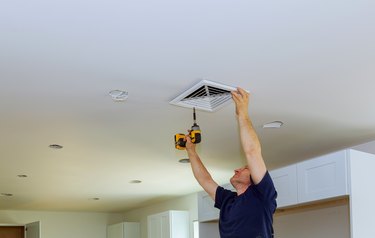
Anyone who relies on a whole-house fan knows that finding one in failure mode is not a happy occasion because these fans serve purposes that air conditioners can't serve. Being able to troubleshoot your whole-house fan is comforting when all you want is to hear those spinning blades drawing cool air, extracting airborne contaminants, pulling out pet odors, and taking the cabbage and broccoli smells anywhere else.
Whole-House Fans Explained
Video of the Day
Whole-house fans are often confused with attic fans. An attic fan — mounted on gable vents and facing outside — simply expels hot air while pulling cooler outside air through roof vents, reducing heat buildup only in your attic space. A whole-house fan — installed in the ceiling between your living space and attic — can reduce home cooling costs by pulling cooler air through open windows, up into the attic and out through attic exhaust vents. This effectively cools the house and the attic at the same time.
Video of the Day
When temperatures are high, attics get hot. Lowering the attic temperature with, for example, cool morning air before things heat up outside can delay the need for your air conditioning system to run and will decrease the work it has to do once it does kick on. The house will cool quicker, the air conditioner will run shorter cycles and your pocket will benefit from energy savings, which is perhaps the best reason to brush up on these recommended troubleshooting tactics.
The Blades Aren't Spinning
If the blades on your whole-house fan stop turning but you can hear the motor humming, it may be that the blades have become positioned off-center and are making contact with the housing, blocking them from turning. If this happens, disconnect your whole-house fan unit and manually adjust the motor bracket back into a centered position.
It may also be the case that the bearings need lubricating. Consult your owner's manual for recommendations. It's crucial that you not overlubricate, and some of today's small motors have permanently lubricated bearings and shouldn't be treated at all. If you can't find your manual, contact the manufacturer or seek help from the person who installed the unit.
The Fan Controls Aren't Working
If your fan doesn't start running when you hit the switch but turns on when you bypass the controls and plug the unit into an outlet, you'll need to call a licensed electrician who can check that the wiring of your switch corresponds to the diagram provided with your unit.
There's No Power
If you need to use an outlet but there's no power when you plug it in, check the outlet with an outlet tester or test it by plugging in another appliance. If it shows no power, call an electrician.
For whole-house systems without power that operate by remote, bypass the remote by removing the remote receiver/relay module and plugging the fan into the outlet. If the outlet works, plug the unit into a second outlet. If the second outlet also works, troubleshoot the unit's control system.
If You're in the Market
If you're considering adding a whole-house fan to your home and often choose to take the DIY approach to installation, be sure you have electrical knowledge about switches and an understanding of the principles of ventilation. Otherwise, plan for a professional installation. If enough ventilation and well-calculated placement of ventilation isn't provided, the fans can cause a backdraft in your furnace, water heater or gas dryer, pulling carbon monoxide into your living space.
Plus, doing research and talking to HVAC professionals may reveal that your house design may preclude having such a system or that your climate — humid, for example — can make whole-house fans altogether unnecessary. Yes, they're great for removing odors, but their primary purpose is, after all, to cool.